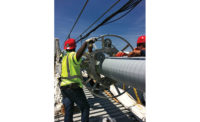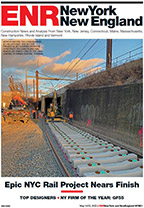New Seismic System May Debut in Turkey
A new isolated bearing system designed to preserve the alignment of critical bridge structures while saving millions in construction costs may make its debut on a high-speed-rail project in Turkey. It has been proposed for California’s planned high-speed-rail system as well.

CCCI Consortium—a design-build partnership of the China Railway Construction Corp., the China National Machinery Import & Export Corp., Istanbul-based Cengiz Insaat and Ankara-based IC Ictas Insaat—plans to include a segmental displaced control isolation system manufactured by Vallejo, Calif.-based Earthquake Protection Systems (EPS) in the second phase of a 533-km-long Ankara-to-Istanbul high-speed-rail line. In March 2009, the Spanish company Obrascon-Huarte-Lain and Alsim-Alarako completed the $747-million first phase: 197 km of double, electrified and signaled line capable of handling trains traveling at up to 250 km per hour from Ankara to Eskisehir.
The more difficult $2-billion, 158-km second phase from Eskisehir to Gebze includes two concrete-box girder bridges with lengths of 1 km and 1.5 km. Construction is planned to start in 2011. Preliminary designs include the EPS system. EPS Vice President Anoop Mokha estimates the new technology will realize a $10 million savings over traditional methods. In addition to improving the chances of preserving operations after an earthquake, the isolated bridge system is less expensive to build because it reduces shear loads in foundations by as much as 20%, according to Mokha.
The system was tested on a 30-ft-long bridge model in May at the Pacific Earthquake Engineering Research (PEER) Simulator Laboratory at UC Berkeley’s Richmond Field Station. The shake table replicated the intensity of historic tremblors, including the 1995 magnitude-6.9 earthquake in Kobe, Japan, but the model train remained operational when the shaking stopped.
The model three-segment bridge combined lock-up guides between the bridge segments, triple-pendulum isolators above the bridge column bents and linear isolation bearings at the ends of the bridge. The lock-up guides limit relative transverse displacement. The connection is rigid in both the vertical and transverse directions but can rotate about its vertical axis, keeping the bridge deck and road centerline continuously aligned during and after an earthquake. Teflon-lined linear isolators allow unidirectional longitudinal sliding while allowing the pieces to rotate 360� around the vertical axis with no tension capacity. Meanwhile, triple- pendulum isolators control the maximum displacement of the bridge decks. For maximum performance at all levels, three different pendulum mechanisms sequentially engage as earthquake shaking increases.
The trio of systems works together to constrain bridge segment movement so that the centerline remains continuous. “It acts like a snake, maintaining alignment and therefore minimizing damage to joints and maintaining functionality after an event,” says Mokha. “Code minimums are currently designed to protect life and safety, but we would like to take it up a notch, protecting infrastructure and maintaining functionality after an earthquake.”
EPS performed seismic retrofit work on the Ataturk Airport International Terminal after the 1999 earthquake. Since then, Turkey has used EPS bearings in 10 important structures. The four major viaducts of the Trans-European Highway all use EPS friction pendulum bearings.
“Leo” Qiyu, an associate in the San Francisco office of Arup, says his company is considering including the new system in the next round of design for the California high-speed-rail system. Some technical issues still need to be addressed, including preserving the rail line on the transition from the roadway embankment to the free-moving bridge, he says.



